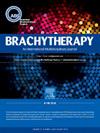3D-printed needle guides for cervical cancer brachytherapy: Optimized dosimetry and improved local control outcomes
IF 1.7
4区 医学
Q4 ONCOLOGY
引用次数: 0
Abstract
PURPOSE
We previously designed three-dimensionally-printed needle guides (3D-NG) for cervical cancer brachytherapy, which improved procedure efficiency and tumor coverage while achieving similar organs at risk (OAR) sparing compared to non-3D-printed techniques (non-3D). The subject of this study was whether 3D-NG can help improve local control and other brachytherapy outcomes.
METHODS
This single institution cohort study includes 130 patients who underwent definitive external-beam radiotherapy and high-dose-rate intracavitary +/− interstitial brachytherapy from February 2017 to July 2023. 3D-NG were implemented for all cases after December 2019 (N = 77). Non-3D included applicator-only/no-needles (N = 28) or freehand-placed needles (N = 25).
RESULTS
Median follow-up was 24 months. 3D-NG, versus non-3D, achieved higher mean D90 (+5.2 Gy, p < 0.001), D98 (+4.3 Gy, p < 0.001), and V100average (+5.9%, p < 0.001)—with greater improvement for larger tumors (high-risk[HR]-CTV>30 cubic-centimeters[cc]) (Pinteraction<0.10 for all). Maximum D2cc for all OAR were comparable between 3D-NG and non-3D (p > 0.05). 2-year LF was lower with 3D-NG compared to non-3D (8.2% vs. 22.0%; aHR 0.31, p = 0.036)—and compared to freehand-needles alone (8.2% vs. 20.6%, p < 0.001 [log-rank])—particularly among cases with higher cumulative HR-CTV dose (D90 >85 Gy; pinteraction = 0.013) and lower HR-CTV volume (≤30 cc; pinteraction = 0.048). 2-year LF was also lower with concurrent cisplatin (aHR 0.20, p = 0.001) and ≥40% decrease in tumor diameter after EBRT (aHR 0.16, p = 0.010); but higher among minority race (aHR 4.21, p = 0.06).
CONCLUSIONS
3D-NG for cervix brachytherapy were associated with improved 2-year LF compared to non-3D/freehand-needles, with higher achievement of EMBRACE II goals for D90 and D98, with similar OAR doses. This study highlights the potential for 3D-NG to simplify needle insertion while simultaneously improving needle position, dosimetry, and disease control outcomes.
用于宫颈癌近距离治疗的3d打印导针:优化剂量测定和改善局部控制结果。
目的:我们之前设计了用于宫颈癌近距离治疗的三维打印导针器(3D-NG),与非3d打印技术(非3d)相比,它提高了手术效率和肿瘤覆盖范围,同时实现了类似的危险器官(OAR)保留。本研究的主题是3D-NG是否有助于改善局部控制和其他近距离治疗结果。方法:该单机构队列研究纳入了2017年2月至2023年7月期间接受明确外束放疗和高剂量率腔内+/-间质近距离放疗的130例患者。2019年12月以后所有病例均采用3D-NG (N = 77)。非3d包括仅使用涂抹器/无针头(N = 28)或徒手放置针头(N = 25)。结果:中位随访时间为24个月。3D-NG与非3d相比,实现了更高的平均D90(+5.2 Gy, p 平均(+5.9%,p 30立方厘米[cc]) (p interaction 0.05)。3D-NG组2年生存率低于非3d组(8.2% vs 22.0%;aHR 0.31, p = 0.036)-与单独使用徒手针头相比(8.2% vs. 20.6%, p 85 Gy;pinteraction = 0.013),HR-CTV体积更低(≤30cc;pinteraction = 0.048)。同时使用顺铂的2年生存率也较低(aHR 0.20, p = 0.001),EBRT后肿瘤直径降低≥40% (aHR 0.16, p = 0.010);但少数民族较高(aHR 4.21, p = 0.06)。结论:与非3d /手绘针相比,用于宫颈近距离治疗的3D-NG与改善的2年LF相关,在OAR剂量相似的情况下,D90和D98的EMBRACE II目标实现更高。这项研究强调了3D-NG在简化针头插入的同时改善针头位置、剂量测定和疾病控制结果的潜力。
本文章由计算机程序翻译,如有差异,请以英文原文为准。
求助全文
约1分钟内获得全文
求助全文
来源期刊

Brachytherapy
医学-核医学
CiteScore
3.40
自引率
21.10%
发文量
119
审稿时长
9.1 weeks
期刊介绍:
Brachytherapy is an international and multidisciplinary journal that publishes original peer-reviewed articles and selected reviews on the techniques and clinical applications of interstitial and intracavitary radiation in the management of cancers. Laboratory and experimental research relevant to clinical practice is also included. Related disciplines include medical physics, medical oncology, and radiation oncology and radiology. Brachytherapy publishes technical advances, original articles, reviews, and point/counterpoint on controversial issues. Original articles that address any aspect of brachytherapy are invited. Letters to the Editor-in-Chief are encouraged.
 求助内容:
求助内容: 应助结果提醒方式:
应助结果提醒方式:


